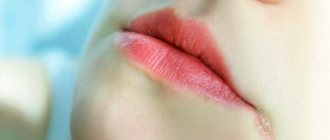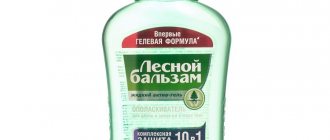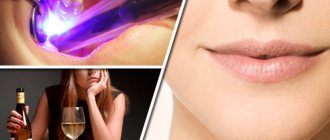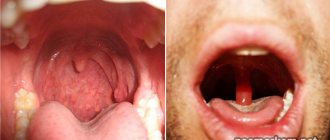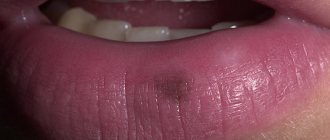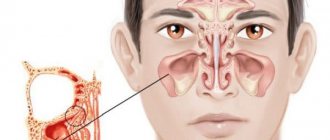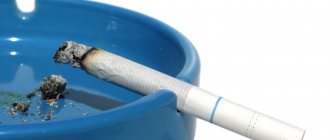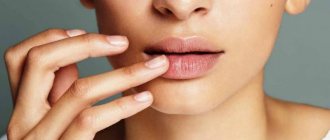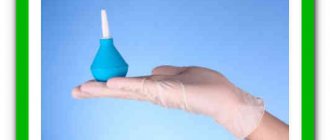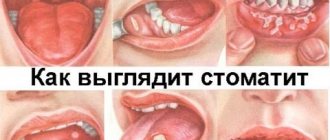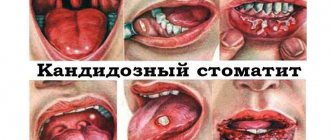What does redness in the corners and around the lips mean?
The most common reason for this phenomenon is ignoring basic protective agents - balms, oils and creams, as well as environmental factors that aggressively affect the skin. However, this can also signal deeper health problems, that is, act as symptoms:
- Gastrointestinal diseases
- Endocrine system failure
- Stressful condition
- Allergic reaction
- Reactions to radiation exposure
- Lack of vitamins B, A
- Fungal infections
If the redness in the corners is chronic and the usual caring procedures do not help you, be sure to consult a doctor. If discomfort and peeling are not a symptom of the disease, use effective, simple and inexpensive remedies that you can even do yourself.
Treatment with pharmaceuticals
Doctors do not recommend self-medication, as this can significantly aggravate the situation, especially if the irritation is caused by an inflammatory process or a fungal infection. In such a situation, it is important to correctly diagnose and identify the source of redness and rash. For this purpose, research is carried out in laboratory conditions.
The allergist will prescribe antihistamines to the patient. The most effective include Elokom and Radevit. They are used to treat diseases of an allergic nature. Suitable medications are available in the form of tablets, solutions, and creams.
Bacterial irritations are treated with medicinal herbs and ointments containing antibiotics. The wounds are disinfected with antimicrobial solutions. Antiseptics are especially effective in combating seizures. To eliminate the problem, it is important to promptly identify the factors that lead to irritation.
Consequences of red lips
Don't neglect treatment and therapy, as what starts as mild dry skin around and on the lips can develop into:
- Chronic cracked lip
- Seizures
- Premature appearance of wrinkles in this area due to insufficient nutrition of the skin
- Peeling and dryness, which will cause significant discomfort
- Sores in the corners
- Suppuration and severe pain due to bacteria trapped in open cracks
- Exfoliative cheilitis - the appearance of crusts along the edges of the lips, severe burning.
- Actinic cheilitis – areas of lip compaction, redness, erosion
It’s difficult to count all the unpleasant phenomena. One thing is clear: problems with the lips will bring not just discomfort, but also aesthetic defects, severe pain, and the development of serious diseases. Eliminate possible causes and start therapy with us.
Symptoms and methods for diagnosing diseases
Peeling skin at the corners of the lips does not indicate a specific problem. At the same time, in order to cure cheilitis, it is necessary to identify the causative factor. The nature of the latter is indicated by accompanying symptoms that occur simultaneously with skin hyperemia.
- In case of recurrence of herpetic infection, the patient is concerned about the following clinical phenomena:
- edema;
- itching;
- burning;
- blistering rashes with serous fluid;
- ulcers.
- Infection with streptococcal infection is indicated by the appearance of vesicular neoplasms, the upper layer of which is lined with epithelium. After such growths are opened, erosions remain in their place, eventually becoming covered with a purulent crust. During this period, the patient experiences intense pain that interferes with eating and talking.
- With candidiasis , caused by infection with the yeast-like fungi Candida, a white coating appears in the affected area. Healthy skin remains untouched. Plaque hides bleeding ulcers.
- Against the background of primary syphilis, neoplasms sometimes develop in the corners of the lips with a red surface. In this case, an ulcer with a dense, gray shell forms on the problem area.
- The development of the inflammatory process is caused by an allergic reaction caused by food, if the corners of the lips are red, there is itching and swelling, but after 1-2 days no blistering rashes appear in the problem area.
- Against the background of nervous overstrain, the above symptoms characteristic of cheilitis also occur. In such circumstances, identifying the true cause of the development of redness is quite difficult. Severe stress, like vitamin deficiency, gastrointestinal pathologies, dermatitis and an allergic reaction, causes peeling and redness of the skin in the corners of the lips.
- We can talk about damage to the salivary glands if the symptoms described above occur with the appearance of aching pain. The course of the inflammatory process is accompanied by the formation of red spots on the lip.
Most pathologies that provoke the appearance of these clinical signs are distinguished by characteristic symptoms. Therefore, treatment of redness and cracks in the mouth is often prescribed based on data from an external examination of the patient.
If necessary, an assessment of the person’s immune status and examination of the gastrointestinal tract are carried out.
How to remove redness in a few hours
Unfortunately, it is possible to completely remove the redness of the corners and borders of the lips only with long-term treatment. But what to do if you need to be, as they say, in shape by the evening, and the defect is in an acute phase of development? Try this:
- If the symptom is observed around the perimeter of the lips, a strong nutrient is needed. For example, butter (100 grams), melted for 10 minutes in a water bath along with 10 grams of propolis.
- Apply a balm based on thermal water with the addition of cocoa or coconut butter to your lips generously.
- Mix a few drops of tea tree oil with a spoon of olive oil and lubricate the skin.
- Apply honey mixed with heavy cream or a spoonful of curd on your lips at night.
Before using each of these recipes, make an application: soak linen or other natural fabric in a concentrated decoction of calendula or chamomile, hold the warm compress for 5 minutes. After this, peel with semolina mixed with clay, oatmeal or flakes, dilute the composition with hot water.
How to quickly remove jams
If peeling is observed only in the corners of your mouth, this most likely means that you have jams. Reconsider your behavior in terms of hygiene and be sure to take treatment, otherwise very soon the corners of your mouth may begin to peel, burn and even bleed.
There are often situations when snags in corners appear at the most inopportune moment and you need to get rid of them as soon as possible. Here's what we have in our arsenal:
- Lubricate the area or lesion with a substance that is produced by the sulfur glands of the ear canal. The remedy has been known since ancient times as one of the most effective.
- Thoroughly grind a teaspoon of homemade cottage cheese with half a spoon of freshly squeezed carrot juice. Apply the mixture in a thick layer on the cheilitis for 5 minutes, rinse with warm water. Repeat after a few hours.
- Place an aloe leaf cut with a plastic knife or broken off, rinse, and put in the refrigerator for several hours. Then squeeze out droplets of juice so that it penetrates into the cracks. Repeat at least once an hour.
- Wash the skin of your lips and around them with thermal water as often as possible. Can be used as an additional remedy to any type of treatment.
- Cut a clove of garlic and apply with the cut side. There may be a slight tingling sensation.
- Lubricate the fireplace with celandine juice several times a day.
- Apply beeswax to the jams, melted in a water bath and mixed with a few drops of sea buckthorn, cocoa, flax or tea tree oil.
Simple recipes often give results that are superior to drug treatment. If seizures do not go away, you should consult a doctor.
Treatment
The method of treating angulitis depends on the reasons that provoked its appearance. What to do in the event of the development of a serious pathology - to treat yourself or go to a doctor - is decided by the person himself. In the absence of proper treatment, cheilitis can turn into purulent abscesses.
- Trauma, bad habits. Correct the prosthesis, temporarily avoid going to the dentist, do not perform active actions with the throat and lips, take proper care of the oral cavity, and brush your teeth thoroughly. It is recommended to numb the surface with lidocaine-based solutions. Treat with antiseptics, stimulate healing with rosehip or sea buckthorn oils. It is also not forbidden to use cream for dryness and flaking.
- Leukoplakia. Stop smoking, eliminate spicy foods from your diet. For therapy, use a solution of vitamin A (topically), E, B6 - orally for 30 days.
- Candidiasis. Apply Lamisil cream three times a day to the crack. Consultation with a specialist is recommended.
- Tuberculosis. Treatment against the background of tuberculosis is carried out in conjunction with the main therapy. Cracks in the corners of the lips are eliminated with an antiseptic and anti-tuberculosis drugs. In such a situation, a person complains that the corners of his lips hurt.
- Syphilis. Therapy is similar to tuberculosis. As an addition, agents to eliminate candidiasis can be used.
- Allergy. The use of antiallergic drugs externally and internally. Termination of exposure to the irritating factor.
- Weather. Reducing time spent outdoors, using lip liner. Treatment with Bepanten, Panthenol.
- Hypovitaminosis B2. Taking B vitamins, visiting a specialized doctor. Rosehip oil and Solcoseryl are used for healing.
- Anemia, thyroid disease, HIV infection. Treatment is carried out taking into account the local picture. Similarly with therapy for candidiasis and leukoplakia.
- Atopic cheilitis. A diet excluding alcohol, sweets, and fatty foods. Taking antiallergic drugs, vitamins. Anesthesia, use of antiseptics, use of steroid liniments: adults – Lorinden-S; children - Traumeel-S.
- Chronic recurrent crack. Maintaining oral hygiene, bandages with solcoseryl, correction of emotional background, treatment of concomitant pathologies.
You should forever give up the habit of licking your lips outside in windy weather.
Folk remedies
Many people are treated with folk remedies, which sometimes drive themselves into a serious trap. Despite the harmlessness of irritation in the pharynx area, it can cause irreparable harm to the body.
- Ear wax will help with cracks in the corners of your mouth. You need to take it out with a cotton swab and lubricate the angulite. This method is also effective for herpes.
- Thermal water is also a good helper in the fight against cracks. An analogue of such treatment is hygienic lipstick. 5-6 times a day is enough for the wounds to begin to heal and go away.
- Goose fat, beeswax, and Vaseline are used for angulitis on the corners of the pharynx. Olive, rose hip, tea tree, and sea buckthorn oils are effective. Infusions of chamomile, calendula, and sage help. To soften the surface of the crust on the crack, it is smeared with honey or butter.
- A common folk remedy for wounds on the corners of the mouth is the juice of Kalanchoe leaves, fresh stems of celandine, plantain, and garlic. The disadvantage of this treatment is the possible burning sensation. It shouldn't be scary.
- Use hair that needs to be rubbed every day along the edges of the lips. Perhaps the method helps, to each his own. They also use the dull side of a knife to remove cracks. They are passed over the inflamed area several times a day.
Conclusion
At the slightest hint of the occurrence of angular stomatitis, it is worth visiting a specialist. He will find out and tell you why the seizures occurred and how to cure them without consequences for the body. Self-medication is acceptable if there is no reason for a serious illness.
You should not immediately begin to eliminate angulitis with improvised means; first, diagnosis is necessary, then competent therapy.
Preventive measures against redness and sticking on the lips
If you don’t want to deal with such unpleasant phenomena as redness, sticking, peeling on the lips, cracks, then develop the following habits:
- Avoid touching your lips with unwashed hands
- Do not put foreign objects in your mouth
- Every time before going outside, apply a nourishing balm, oil or oil-based cream
- Never use other people's towels or dirty dishes.
- If necessary, take a course of multivitamins, especially in the off-season.
- Take good care of your lips and the skin around them. The norm should be daily cleansing and nutrition. Do peelings and nourishing masks once a week.
- Take care of your health: eat right, drink less alcohol.
- Use only natural, proven cosmetics.
- Try to avoid using long-lasting or highly pigmented lipsticks.
- Make sure you are not allergic to the care products used.
Redness, cracks and jams are a minor problem. But only those who have not encountered a similar situation can say this.
